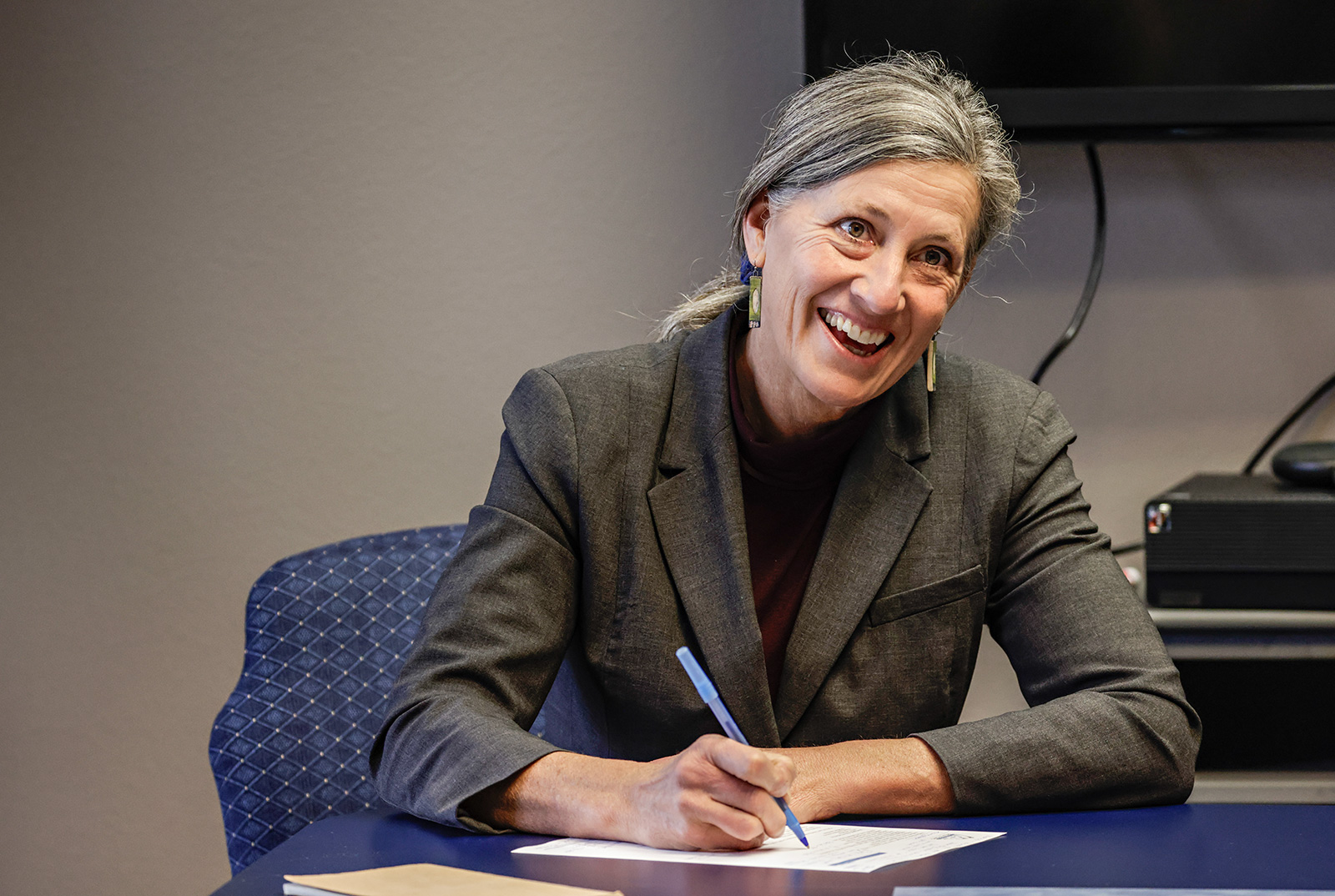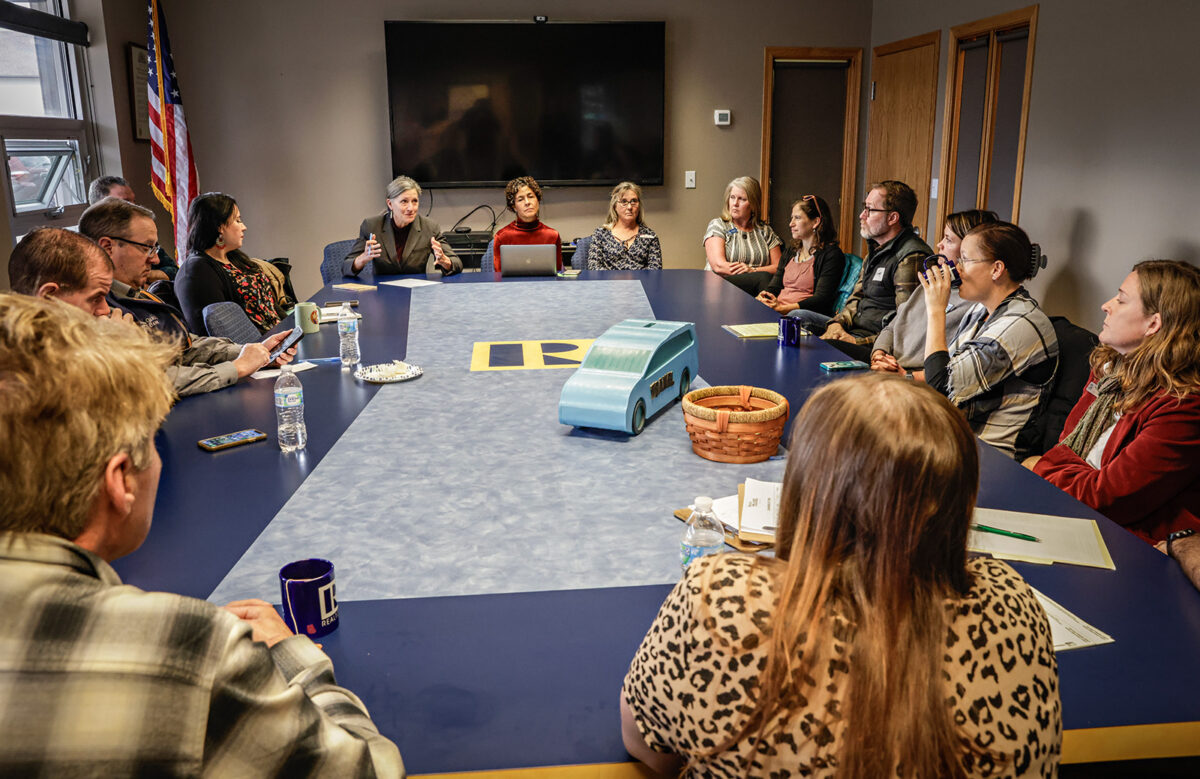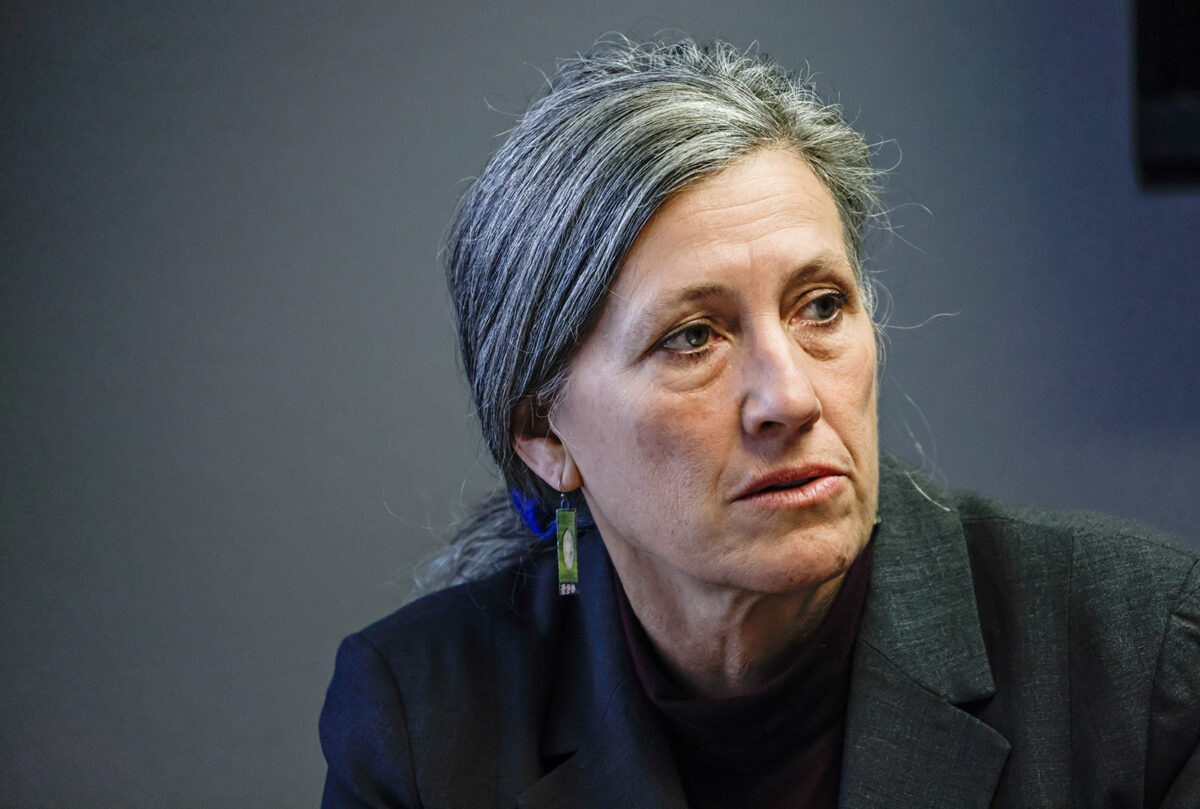Local Stakeholders Lay Bare Housing Issues at Tranel Campaign Roundtable
During the Congressional candidate’s stop in Kalispell, realtors, public officials and nonprofit leaders outlined a number of factors putting pressure on the Flathead Valley’s housing market
By Denali Sagner
Fifteen community stakeholders met with Congressional candidate Monica Tranel in Kalispell on Wednesday to discuss housing affordability and homelessness in the Flathead Valley.
“I’ve traveled this district now for years, and people say, ‘What issue are you hearing about?’ And I say, ‘Housing, housing and housing,’” Tranel said.
During the hour-long affordable housing roundtable, Tranel spoke little about her campaign, and rather sat back as local realtors, nonprofit leaders and public officials recounted difficulties with high interest rates, low housing supply and a lack of adequate social services in northwest Montana. The Missoula attorney and Democratic candidate for Montana’s Western U.S. House District gave the floor to each of the community leaders, asking them to discuss their work and to offer ideal solutions to the patchwork problems of homelessness and housing affordability.
The roundtable drew representatives from the Northwest Montana Community Land Trust, Shelter WF, the Northwest Montana Association of REALTORS, the Flathead Warming Center, Flathead Building Association, Rural Assistance for Communities, the cities of Whitefish and Kalispell, NeighborWorks Montana, KCM Enterprises, Terry Homes, the Abbie Shelter, the Samaritan House and Glacier Bank.
The discussion between Tranel and community leaders covered a number of forces exerting pressure on the region’s housing market, from the high cost of materials and land to the vacation home market to the state’s dysfunctional behavioral health system.
“There’s no place for folks to move out of our shelter,” Hilary Shaw, executive director of the Abbie Shelter, a Kalispell-based nonprofit that provides services to survivors of domestic violence and abuse, said, explaining that domestic violence is a leading cause of homelessness for women.
Shaw said that a lack of inventory has made it difficult for the Abbie Shelter to get clients into stable housing, and that the majority of clients who leave the shelter move in with friends and family.
Shaw is also a member of the board of directors for Housing Whitefish, a nonprofit that works with the Whitefish Housing Authority.
“Our two biggest reasons that people have difficulty leaving the shelter and going into housing is the affordability of housing, and also the scarcity of mental health services,” Chris Krager, executive director of the Samaritan House, a homeless shelter in Kalispell, said.
Krager described a “slow, gradual decline” of mental health services in Flathead County driven in part by dwindling Medicaid reimbursement rates in Montana.

Representatives from the Flathead Valley’s real estate market pointed to exorbitant land, labor and materials prices, state and federal housing policies, climate risks and high interest rates, as reasons why supply has not kept up with demand for homes in northwest Montana.
“We have been struggling with material and labor prices,” said Merna Terry, operations manager for Terry Homes, a home building company whose mission is to “build homes for people who live and work in the valley.”
Terry said that though her company has attempted to build homes in the most affordable manner possible, the cheapest price they could reach is $399,000, a pricetag that far exceeds the budget of many workers in the Flathead Valley.
According to a report by Fortune, a homebuyer would need to make $132,000 per year to be able to afford a $400,000 home in the United States. The median household income in Flathead County in 2021 was $65,835, according to the U.S. Bureau of Labor Statistics. The starting salary for teachers in the Kalispell Public Schools is $34,652. Police officers in the city of Whitefish see a starting salary of $60,000.
The median sales price for a home in October 2023 was $594,500 in Kalispell, $884,500 in Whitefish, $495,000 in Columbia Falls, $665,250 in Bigfork, and $628,000 in Flathead County at large.
“You cannot even come close to building at an affordable rate. It’s just impossible,” Casey Malmquist, owner of KCM Enterprises, said.

Malmquist said that the solution to the housing crisis is tied up in figuring out who “funds the gap” between the high cost of construction and the unaffordable price of home rentals. The Whitefish builder suggested that large-scale, private businesses wrap housing in with their employment packages and bemoaned the culture of “NIMBY-ism” that has stalled development in the valley.
Stakeholders also highlighted a number of federal programs that they say have helped to alleviate the area’s strained housing economy, and offered criticism of others.
Doug Russell, city manager of Kalispell, said that the federal Low-Income Housing Tax Credit has “proven the test of time” and is an effective, efficient way to put much needed capital “right back into the market.”
Erica Wirtala, public affairs director for the Northwest Montana Association of REALTORS, advocated for the continuation of the federal Home Mortgage Interest Deduction, subsidies through the National Flood Insurance Program, and said that the federal government should help cover wildfire insurance, which is becoming prohibitively expensive and inaccessible as insurers begin to pull out of fire-prone areas.
Bill Leininger, a realtor and past president of the Northwest Montana Association of Realtors, said that he and his colleagues are beginning to see sites in the Flathead Valley where homebuyers are unable to purchase wildfire insurance due to high costs and the refusal of insurance companies to provide coverage as extreme weather events such as fires increase in intensity and frequency.
“We’re at a time where we’re having a lot of financial risk, losses — flood, wind, fire — but we also are having a very, very high time of replacement costs,” Leininger said.
Dana Smith, city manager of Whitefish, said that the federal government should reconsider the income limits for public housing. Currently, the U.S. Department of Housing and Urban Development (HUD) sets an income limit at 80% of the area median income (AMI) for individuals to qualify for low-income housing. In Whitefish, Smith said, the 80% AMI limit “doesn’t apply.”
“You’re helping a very small set subset,” Smith said of Whitefish, where the 80% AMI amounts to an annual salary of $85,100.

Federal housing programs, while important, are failing to assist the “missing middle” in Whitefish that can no longer afford housing, Smith said.
Smith laid bare the unique pressures faced by the resort town, where housing prices have far outpaced the rest of the Flathead Valley and out-of-state home purchases and short-term rentals have displaced longtime residents.
“Whitefish is unique to the valley,” Smith said. “In Whitefish, the demand is so high. We can increase density, but if we don’t put requirements on those homes being affordable, then they’re going market rate and it’s going to out-of-state individuals.”
According to the 2022 Whitefish Area Community Housing Needs Assessment, the city will need 1,310 housing units by 2030 to keep up with future growth. Of the 1,310 units, 75% need to be priced below market rate to support local residents and employees.
Tranel announced her second run for Congress in July, setting up a likely rematch with Montana’s Republican U.S. Rep. Ryan Zinke, who Tranel lost to by 7,837 votes in 2022. Tranel, an attorney and former Olympic rower, has painted herself as a moderate alternative to Zinke and has distanced herself from national Democrats while emphasizing her Montana roots. In campaign events across western Montana, Tranel has honed in on rising utility costs, privacy issues, including Montanans’ right to an abortion, and climate change.
“All politics is local. I live here. This is my home. I don’t have another one. I work here. I play here. I think what we’re seeing is people want representation that looks like them, works for them, is part of representative democracy,” Tranel told the Beacon on Wednesday. “People want their communities to have a voice, and that’s why I’m running.”